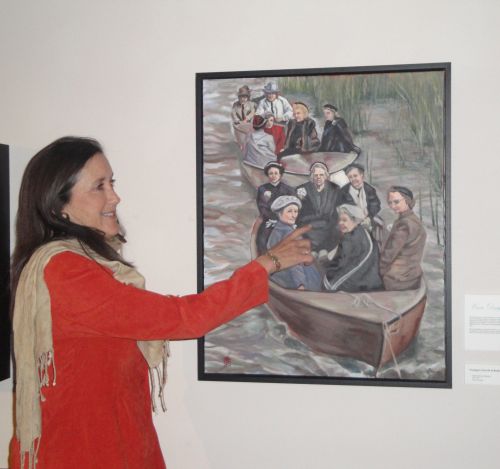
Motorsports Park regularly hosts Kart racing, too
April 3, 2013
Andrew Calise Freeman
April 8, 2013The newest tool being used to promote the need for coastal preservation and restoration focuses on the culture and heritage that washes away with the land.
“I Remember…,” an art collection commemorating the culture, heritage and landscape of coastal Louisiana, is on exhibit through May 8 at National Historical Park and Preserve’s Wetlands Acadian Cultural Center. It features environmental landscapes portraits of coastal stewards – people who embody the spirit and practice of all who grew up and work along the coast – by Lane Lefort as well as oil paintings depicting daily life along the Lower Mississippi River by Marian Brister Martinez.
“That’s my great-grandmother,” Theresa M. Gravolet, says a stunned Albertine Kimble, pointing to a woman sitting in a boat in Brister’s painting, “Going to Fort de la Boulaye.” “I’ve got the original photo of that painting,” which depicts the boat trip made by a group of ladies for the dedication of a plaque commemorating the original Fort de la Boulaye built in 1700 after France took control of the Mississippi River.
“That’s amazing. That really takes me by surprise,” says Kimble, Plaquemines Parish’s coastal zone program manager who almost didn’t attend the exhibit’s opening reception March 13 due to her busy schedule.
“These things are changing. These memories are who we are,” says Brister, who grew up on the banks of the Mississippi River in Triumph, La. “It’s important to pass them along to our children and grandchildren so they have a sense of place.”
Her paintings focus on the way of life when the Mississippi River was the main mode of transportation, drawn from photographs found in her grandparents’ closet as well as in the public domain. She remembers, as a child, dressing up and crossing the river in a boat to visit her uncle at Fort St. Philip in Plaquemines Parish.
“It’s great to see this union of art and culture,” Lt. Gov. Jay Dardenne said during the exhibit’s opening. “It’s a real tangible way to reflect on what Louisiana used to look like… No state in America ought to preserve its artistic history more than Louisiana” for the state has produced many artists, writers and chefs who work with the state’s abundance of natural resources.
Lefort, of Marrero, says he tries to capture the feeling of the marsh in his photographs. His portraits set people whose oral histories of living in the Barataria-Terrebonne Basin were recorded for the exhibit in the backgrounds of their daily lives.
Among those featured are Buddy Daisy of Dulac, oysterman; Dr. Earl Melancon, professor of biological sciences at Nicholls State University; Cindy Cutrera, manager of economic development for the Port of Morgan City; Kerry St. Pe’ of Raceland, executive director of the Barataria-Terrebonne National Estuary Program; Davie Breaux, director of operations for Port Fourchon; and Brenda Dardar Robichaux of the United Houma Nation. Crabber and alligator hunter Yancey Welch, education curator of the Historic New Orleans Collection Susan “Sue” Laudeman, retired shrimper Eddie Sapai Jr., landowner Marietta Smith Greene, and landowner, farmer and CWPPRA activist Sherrill Sagrera round out the list of coastal stewards.
The exhibit uses modern technology to share information: by scanning the paintings’ QR codes with a smartphone, viewers can hear oral histories from the photograph’s subjects. A kiosk also plays the video interviews. To expand the effort, exhibit viewers are urged to fill out memory pledge cards on which they promise to tell stories to children to keep their heritage alive.
The exhibit “means a lot to me because they need to do something about the islands and wetlands,” Daisy, the oysterman, says. “They need to preserve our islands and seafood industry” because as the land is lost, so is the livelihood that depends upon it.
“This is another step in preserving that culture,” Dardenne said. “It’s important to preserve Louisiana culture and preserve land as well as it can be.”
“The goal of this unique art show is to turn it into a traveling exhibit not just in Louisiana but around the nation,” says Susan Testroet Bergeron, Coastal Wetlands Planning, Protection and Restoration Act outreach coordinator and education specialist. “Our nation needs to understand the diverse population and distinctive culture that has been working for years in Louisiana’s wetlands to provide national resources as varied as seafood, oil and gas, and a conduit for navigation into the United States.”
The oral histories and a photo were commissioned by CWPPRA to further the goal of protecting and restoring Louisiana’s wetlands, Bergeron said, but the final portraits, the nature photographs and paintings were shared by the artists to help the public better understand the need for restoration.
“We’re losing two assets at the same time – people and their stories, and the coast,” Lefort said. “It’s a race to see which one we will lose first.”
The exhibit is open through May 8 at the Wetlands Acadian Cultural Center, 314 St. Mary St., Thibodaux. Admission is free. For more information, call (985) 448-1375. Listen to coastal stewards’ interviews at www.lacoast.gov/new/GetInvolved/ OralHistory.aspx.
Albertine Kimble, of Plaquemines Parish, points out her great-grandmother in the painting, “Going to Fort de la Boulaye,” being shown in the “I Remember…” exhibit at Wetlands Acadian Cultural Center in Thibodaux.
Lt. Gov. Jay Dardenne addresses the importance of preserving coastal wetlands, livelihoods and culture while photographer Lane Lefort and artist Marian Brister Martinez look on.








